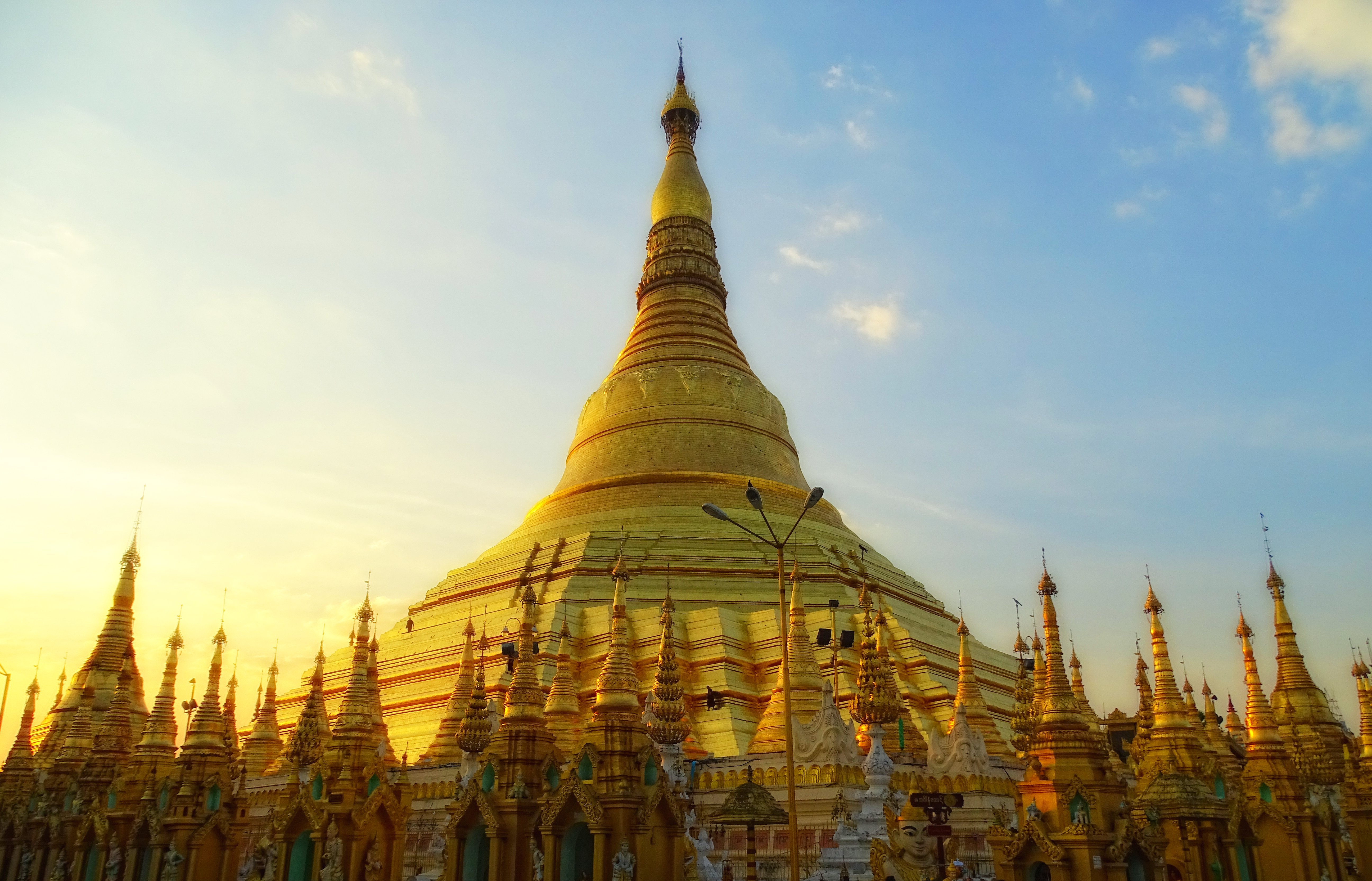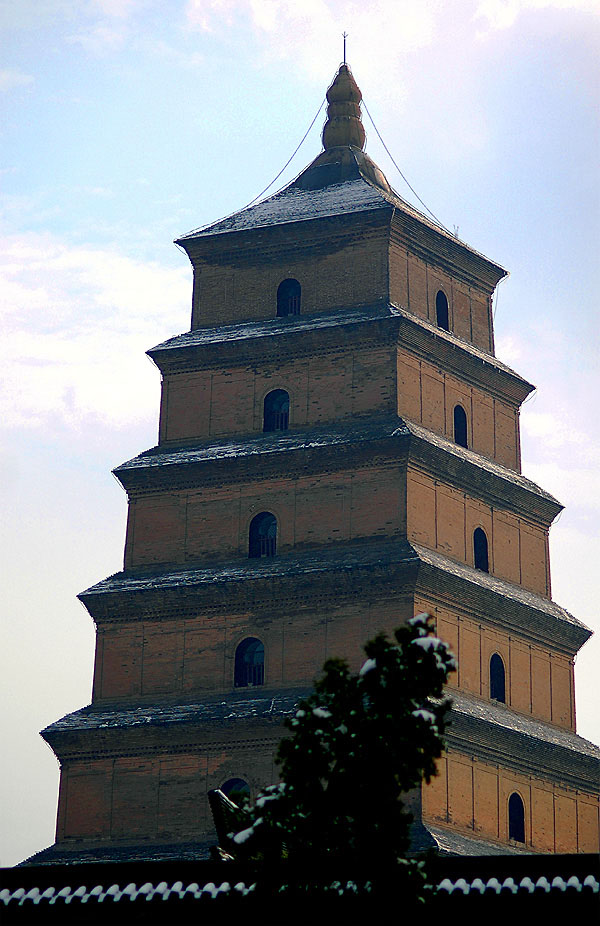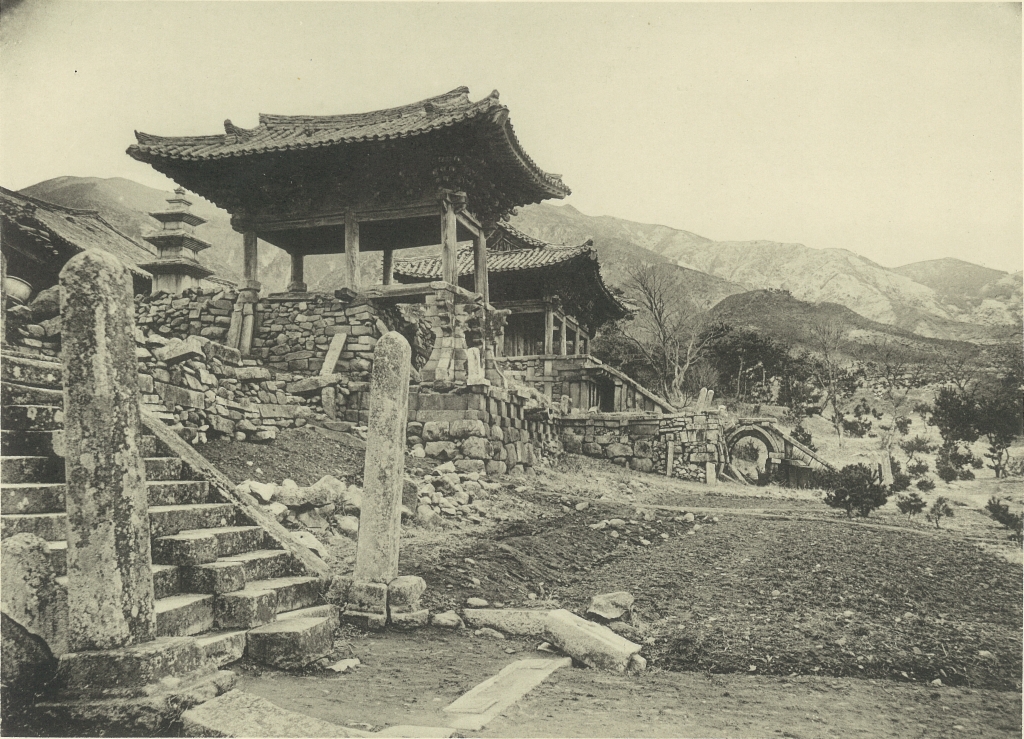|
Pagoda
A pagoda is a tiered tower with multiple eaves common to Thailand, Cambodia, Nepal, India, China, Japan, Korea, Myanmar, Vietnam, and other parts of Asia. Most pagodas were built to have a religious function, most often Buddhist, but sometimes Taoist or Hindu, and were often located in or near viharas. The pagoda traces its origins to the stupa, while its design was developed in ancient India. Chinese pagodas () are a traditional part of Chinese architecture. In addition to religious use, since ancient times Chinese pagodas have been praised for the spectacular views they offer, and many classical poems attest to the joy of scaling pagodas. The oldest and tallest pagodas were built of wood, but most that survived were built of brick or stone. Some pagodas are solid with no interior. Hollow pagodas have no higher floors or rooms, but the interior often contains an altar or a smaller pagoda, as well as a series of staircases for the visitor to climb to see the view from a ... [...More Info...] [...Related Items...] OR: [Wikipedia] [Google] [Baidu] [Amazon] |
Shwedagon Pagoda
The Shwedagon Pagoda (, ; ), officially named ''Shwedagon Zedi Daw'' (, , ), and also known as the Great Dagon Pagoda and the Golden Pagoda, is a gilded stupa located in Yangon, Myanmar. The Shwedagon is the most sacred Buddhist pagoda in Myanmar, as it is believed to contain relics of the four previous Buddhas of the present kalpa. These relics include the staff of Kakusandha, the water filter of Koṇāgamana, a piece of the robe of Kassapa, and eight strands of hair from the head of Gautama. Built on the Singuttara Hill, the tall pagoda stood above sea level,The pagoda's pinnacle height (to the tip of its ''hti'') is tall per (UNESCO 2018), and is built on the Singuttara Hill, which is tall per , and tall above sea level per and dominates the Yangon skyline. Yangon's zoning regulations, which cap the maximum height of buildings to above sea level (75% of the pagoda's sea level height), ensure the Shwedagon's prominence in the city's skyline. History Legend ... [...More Info...] [...Related Items...] OR: [Wikipedia] [Google] [Baidu] [Amazon] |
Giant Wild Goose Pagoda
Giant Wild Goose Pagoda or Big Wild Goose Pagoda (, ), is a monumental Buddhist pagoda located in southern Xi'an, Shaanxi, China. It was built in during the Tang dynasty and originally had five stories. It was rebuilt in 704 during the reign of Empress Wu Zetian and its exterior brick façade was added during the Ming dynasty. One of the pagoda's many functions was to hold sutras and figurines of Gautama Buddha that were brought to China from India by the seventh-century Buddhist monk, scholar, traveller, and translator Xuanzang. Today, the interior walls of the pagoda feature engraved statues of Buddha by the renowned 7th-century artist Yan Liben. This pagoda was added to the World Heritage List, along with many other sites along the Silk Road, as part of the " Silk Roads: the Routes Network of Chang'an-Tianshan Corridor" site in 2014. Surroundings and history The original pagoda was built during the reign of Emperor Gaozong of Tang (r. 649–683), then standing at a heig ... [...More Info...] [...Related Items...] OR: [Wikipedia] [Google] [Baidu] [Amazon] |
Yangon
Yangon, formerly romanized as Rangoon, is the capital of the Yangon Region and the largest city of Myanmar. Yangon was the List of capitals of Myanmar, capital of Myanmar until 2005 and served as such until 2006, when the State Peace and Development Council, military government relocated the administrative functions to the purpose-built capital city of Naypyidaw in north central Myanmar. With over five million people, Yangon is Myanmar's most populous city and its most important commercial centre. Yangon boasts the largest number of colonial-era buildings in Southeast Asia, and has a unique Downtown Yangon, colonial-era urban core that is remarkably intact. The colonial-era commercial core is centered around the Sule Pagoda, which is reputed to be over 2,000 years old. The city is also home to the gilded Shwedagon Pagoda – Myanmar's most sacred and famous Buddhist pagoda. Yangon suffers from deeply inadequate infrastructure, especially compared to other major cities in Sou ... [...More Info...] [...Related Items...] OR: [Wikipedia] [Google] [Baidu] [Amazon] |
Chinese Architecture
Chinese architecture () is the embodiment of an architectural style that has developed over millennia in China and has influenced architecture throughout East Asia. Since its emergence during the early ancient era, the structural principles of its architecture have remained largely unchanged. The main changes involved diverse decorative details. Starting with the Tang dynasty, Chinese architecture has had a major influence on the architectural styles of neighbouring East Asian countries such as Japanese architecture, Japan, Korean architecture, Korea, Vietnamese architecture, Vietnam, and Mongolian architecture, Mongolia in addition to minor influences on the architecture of Southeast and South Asia including the countries of Malaysia, Singapore, Indonesia, Sri Lanka, Thailand, Laos, Cambodia, and the Philippines. Chinese architecture is characterized by bilateral symmetry, use of enclosed open spaces, feng shui (e.g. directional Hierarchy, hierarchies), a horizontal emphasis, a ... [...More Info...] [...Related Items...] OR: [Wikipedia] [Google] [Baidu] [Amazon] |
The Five-Storied Pagoda
''The Five-Storied Pagoda'' (Gojūnotō, 五重塔) is a novella by writer Kōda Rohan. “It was originally written as a serialized piece of fiction in the intellectual newspaper Kokkai (Diet, or Parliament), beginning in November 1891 and ending in March of the following year. As a consequence, chapter divisions in this story ��do not necessarily coincide with the breaks in plot progression or narrative pauses.”(15). The pagoda in the story is based on a pagoda donated to Tokyo by Tennō-ji. Plot Synopsis Jūbei is a poor carpenter working under the master architect Genta. When the Abbot proposes the construction of a new pagoda, Jūbei insists that he take charge of the construction. The Abott has pity on Jūbei. Genta proposes cooperation between the two, but Jūbei rejects his offer. The Abott finally gives Jūbei full authority over the project. One of Genta's servants, Seikichi, is furious about Jūbei rejecting his master's offer which makes him lose face. Sei ... [...More Info...] [...Related Items...] OR: [Wikipedia] [Google] [Baidu] [Amazon] |
Liuhe Pagoda
Liuhe Pagoda (), literally Six Harmonies Pagoda, is a multi-story Chinese pagoda in southern Hangzhou, Zhejiang province, China. It is located at the foot of Yuelun Hill, facing the Qiantang River. It was originally constructed in 970 by the Wuyue Kingdom, destroyed in 1121, and reconstructed fully by 1165, during the Southern Song dynasty (1127–1279). History and background The pagoda was originally constructed by the ruler of the Wuyue Kingdom, whose capital was Hangzhou. The name ''Liuhe'' comes from the six Buddhist ordinances and it is said that the reason for building the pagoda was to calm the tidal bore of the Qiantang River and as a navigational aid. However, the pagoda was completely destroyed during warfare in the year 1121. After the current pagoda was constructed of wood and brick during the Southern Song dynasty, additional exterior eaves were added during the Ming dynasty, Ming (1368–1644) and Qing dynasty, Qing Dynasties (1644–1911). The pagoda is octagonal ... [...More Info...] [...Related Items...] OR: [Wikipedia] [Google] [Baidu] [Amazon] |
Xi'an
Xi'an is the list of capitals in China, capital of the Chinese province of Shaanxi. A sub-provincial city on the Guanzhong plain, the city is the third-most populous city in Western China after Chongqing and Chengdu, as well as the most populous city in Northwestern China. Its total population was 12.95 million as of the 2020 census, including an urban population of 9.28 million. Known as Chang'an throughout much of its history, Xi'an is one of China's Historical capitals of China, Four Great Ancient Capitals, having held the position under several of the most important dynasties in Chinese history, including the Western Zhou, Qin dynasty, Qin, Western Han, Sui dynasty, Sui, Northern Zhou and Tang dynasty, Tang. Xi'an is now the second-most popular tourist destination in China. The city was one of the terminal points on the Silk Road during the ancient and medieval eras, as well as the home of the 3rd-century BC Terracotta Army commissioned by Emperor Qin Shi Huan ... [...More Info...] [...Related Items...] OR: [Wikipedia] [Google] [Baidu] [Amazon] |
Stupa
In Buddhism, a stupa (, ) is a domed hemispherical structure containing several types of sacred relics, including images, statues, metals, and '' śarīra''—the remains of Buddhist monks or nuns. It is used as a place of pilgrimage and meditation. Walking around a stupa in a clockwise direction, known as '' pradakhshina'', has been an important ritual and devotional practice in Buddhism since the earliest times, and stupas always have a ''pradakhshina'' path around them. The original South Asian form is a large solid dome above a tholobate, or drum, with vertical sides, which usually sits on a square base. There is no access to the inside of the structure. In large stupas, there may be walkways for circumambulation on top of the base as well as on the ground below it. Large stupas have, or had, ''vedikā'' railings outside the path around the base, often highly decorated with sculpture, especially at the torana gateways, of which there are usually four. At the top of ... [...More Info...] [...Related Items...] OR: [Wikipedia] [Google] [Baidu] [Amazon] |
Zhenhai Tower (Guangzhou)
The Zhenhai Tower, also known as the Five-Story Pagoda, is a tower in Guangzhou, Guangdong. It is located in Yuexiu Park, in central Guangzhou. It now houses the Guangzhou Museum. History It was first built in 1380, at the beginning of the Ming dynasty, by the Yongjia Marquis Zhu Liangzu (). The tower is in height, in width and in depth. Popular culture By the time it was the highest building of Guangzhou when it was constructed. For a long period of time, it was the symbol of Guangzhou before the The Legend of Five Goats, Five Goats Statue was built. Gallery See also * Yuexiu Hill References External links Guangzhou Museum Buildings and structures completed in 1380 Towers completed in the 14th century Buildings and structures in Guangzhou Yuexiu District Ming dynasty architecture Museums in Guangzhou History museums in China Art museums and galleries in China National first-grade museums of China 1380 establishments in Asia {{PRChina-museum-stub ... [...More Info...] [...Related Items...] OR: [Wikipedia] [Google] [Baidu] [Amazon] |
Seokgatap
Seokgatap () is a Silla-era stone pagoda in the temple Bulguksa in Gyeongju Gyeongju (, ), historically known as Seorabeol (, ), is a coastal city in the far southeastern corner of North Gyeongsang Province, South Korea. It is the second largest city by area in the province after Andong, covering with a population of ..., South Korea. It was designated National Treasure of South Korea No. 21 on December 20, 1962. The pagoda stands 10.75 meters high and directly across from another pagoda Dabotap. It probably dates to around 751, when Bulguksa was completed. Description The Seokgatap is in distinct contrast with its more elaborate brother the Dabotap. The pagoda is of a very simple and basic design and the three stories have a pleasing 4:3:2 ratio which gives the pagoda a sense of balance, stability, and symmetry. The contrast between the simplicity of the Seokgatap and the complexity of the Dabotap is designed to represent the dual nature of the Buddha's contemplation a ... [...More Info...] [...Related Items...] OR: [Wikipedia] [Google] [Baidu] [Amazon] |
Myanmar
Myanmar, officially the Republic of the Union of Myanmar; and also referred to as Burma (the official English name until 1989), is a country in northwest Southeast Asia. It is the largest country by area in Mainland Southeast Asia and has a population of about 55 million. It is bordered by India and Bangladesh to its northwest, China to its northeast, Laos and Thailand to its east and southeast, and the Andaman Sea and the Bay of Bengal to its south and southwest. The country's capital city is Naypyidaw, and its largest city is Yangon (formerly Rangoon). Early civilisations in the area included the Tibeto-Burman-speaking Pyu city-states in Upper Myanmar and the Mon kingdoms in Lower Myanmar. In the 9th century, the Bamar people entered the upper Irrawaddy River, Irrawaddy valley, and following the establishment of the Pagan Kingdom in the 1050s, the Burmese language and Culture of Myanmar, culture and Buddhism in Myanmar, Theravada Buddhism slowly became dominant in the co ... [...More Info...] [...Related Items...] OR: [Wikipedia] [Google] [Baidu] [Amazon] |
Bulguksa
Bulguksa () is a Buddhist temple on Tohamsan, in Jinhyeon-dong, Gyeongju, North Gyeongsang Province, South Korea. It is a head temple of the Jogye Order of Korean Buddhism and contains six National Treasures, including the Dabotap and Seokgatap stone pagodas, Cheongun-gyo (Blue Cloud Bridge), and two gilt-bronze statues of Buddha. The temple is classified as ''Historic and Scenic Site No. 1'' by the South Korean government. In 1995, Bulguksa and the nearby Seokguram Grotto were added to the UNESCO World Heritage List. The temple is considered as a masterpiece of the golden age of Buddhist art in the Silla kingdom. It is currently the head temple of the 11th district of the Jogye Order of Korean Buddhism. Among the earliest woodblock prints in the world, a version of the Dharani sutra dated between 704 and 751 was found there in 1966. Its Buddhist text was printed on a mulberry paper scroll. History The temple's records state that a small temple was built on this site unde ... [...More Info...] [...Related Items...] OR: [Wikipedia] [Google] [Baidu] [Amazon] |








